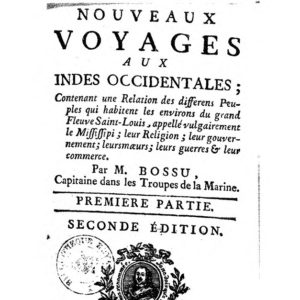calsfoundation@cals.org
Jean Bernard Bossu (1720–1792)
Jean Bernard Bossu was a French captain and adventurer who explored the region of the Mississippi River while Louisiana was a French colony. During his voyages, Bossu wrote extensive letters about his adventures among the natives of the Mississippi River Valley. The letters were published in two volumes, and both were translated into English. Influenced by Jean-Jacques Rousseau’s image of the “noble savage,” Bossu claimed that the Quapaw Indians were “capable of heroism, humanism, and virtue”; these people were not “barbarians” or “savages” but actual human beings. Although scholars have pointed out some inconsistencies and historical inaccuracies in his letters, the letters remain an important primary source on the early period of the history of French Louisiana. His work is of interest for scholars of the Quapaw, Illinois, Alabama, Natchez, Chickasaw, Caddo, Choctaw, Osage, Yazoo, and other Native Americans.
Jean Bernard Bossu was born on September 29, 1720, in Baigneux-Les-Juifs, France. Although born into a family of surgeons, he chose to be a soldier. By 1744, Bossu distinguished himself during the siege of Chateau-Queyras and became a lieutenant. His position as a captain in the French navy enabled him to travel to the New World in 1751, 1757, and 1770.
Bossu departed from Ile de Re, France, on December 26, 1750, among a group sent to reinforce the garrison at New Orleans. By mid-February 1751, Bossu and the troops had arrived at Cap François, Santo Domingo. After a short stay, Bossu sailed for New Orleans on March 8 and reached his destination in early April.
Bossu left New Orleans to explore the Mississippi River and the Native American populations that lived on its banks. Bossu stayed in what used to be the lands of the Natchez. From Natchez, Bossu sailed up the Mississippi River and arrived among the Arkansas (les Akanças), also known as the Quapaw, who were famous for their attachment to the French. Bossu reported the tales of a “noble savage” who witnessed the second expedition of René-Robert Cavelier, Sieur de La Salle and his death. Welcomed by the Quapaw, Bossu was offered to smoke the calumet and to be adopted into the tribe. The painful part of the adoption ritual, according to Bossu, was the leg tattoo. The Quapaw told him that he would now be received by all their allies as if he were their brother, and that the Quapaw would take revenge if he were killed. While he was in what is now Arkansas, he stayed at Arkansas Post and traveled along the Arkansas River. In mid-November 1751, Bossu left the Quapaw to continue his travels up the river to the country of the Illinois.
In the spring of 1757, Bossu went back to France. After he informed the minister of the navy, François Marie Peyrenc de Moras, about the situation in the colony, he received orders to go back to New Orleans immediately. Once Bossu was in New Orleans, Governor Louis Billouart, Chevalier de Kerlérec sent him to the fort des Allibamons. Bossu was disappointed when de Kerlérec gave the command of this fort to a less experienced officer and criticized the governor for it. Because of his criticism of the governor, Bossu was later sent to prison for six weeks (when he was in France in 1768). In 1759, de Kerlérec nominated him to head a convoy sent to Fort Tombekbe, located among the Choctaw.
Bossu returned to New Orleans in 1759. Little is known about Bossu’s activities from then until January 1763, when he returned to France. Bossu’s letters of these first two voyages, Nouveaux Voyages aux Indes Occidentales, were published in 1768. By the time of Bossu’s third voyage to Louisiana, the colony was no longer under French authority. The Treaty of Paris (1763) divided French Louisiana between the British and the Spanish.
Bossu left France for his third and last trip to the New World in 1770. A collection of his letters about his last trip, Nouveaux Voyage dans l’Amérique Septentrional, were published in 1777. Bossu described his stay in the Caribbean and depicted the revolt of the inhabitants of Louisiana against the Spanish rule in 1768. He arrived at New Orleans in July 1770. Shortly after, he visited the Quapaw, who assured him that “his children, les Akanças, cried out [his] absence since fourteen harvests and six moons.” When he left in 1771, Bossu wrote: “It is with a great regret that I will leave the Akanças, whom I might not ever see again.”
Indeed, Bossu arrived to Bordeau in August 1771 and settled in the region of the Bourgogne. He lived in Auxerre then moved to Aisey-sur-Seine, where he spent some time with one of his nephews. He died in Montbard in 1792.
For additional information:
Bossu, Jean Bernard. Nouveaux Voyages aux Indes Occidentales; Contenant une Relation des différent Peuples qui habitent les environs du grand Fleuve Saint-Louis, appellé vulgairement le Mississippi; leur religion; leur gouvernement; leurs moeurs; leurs guerres et leur commerce. Paris: 1768.
———. Nouveaux voyage dans l’Amérique septentrionale, Contenant une collection de Lettres écrites sur les lieur, par l’auteur, a son ami M. Douin, Chevalier, Capitaine dans les troupes du Roi, Ce Devant Son Camarade Dans Le Nouveau Monde. Amsterdam: 1777.
———. Nouveaux Voyages en Louisiane 1751–1768. Edited by Philippe Jacquin. Paris: Aubier Montaigne, 1994.
English translations of the works above:
Feiler, Seymour. Jean Bernard Bossu’s Travels in the Interior of North America, 1751–1762. Norman: University of Oklahoma Press: 1962.
Dickinson, Samuel. New Travels in North America by Jean-Bernard Bossu, 1770–1771. Natchitoches: Northwestern State University, 1982.
L’Association Baigneux Archives (Baingeux-Les-Juifs, Cote D’Or). “Jean-Bernard Bossu, un Enfant du Pays en Louisiane au Temps de Louis XV.” Le Bulletin 2.2 (March 2006): 1.
Sonia Toudji
University of Arkansas, Fayetteville
 European Exploration and Settlement, 1541 through 1802
European Exploration and Settlement, 1541 through 1802 French Explorers and Settlers
French Explorers and Settlers Bossu Book
Bossu Book 




Comments
No comments on this entry yet.